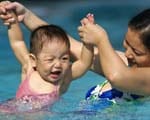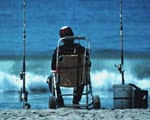How a child turns out determined by nature, nurture — and parental guidance shaped by child’s strengths
Why does a child grow up to become a lawyer, a politician, a professional athlete, an environmentalist or a churchgoer?
It’s determined by our inherited genes, say some researchers. Still others say the driving force is our upbringing and the nurturing we get from our parents.
But a new child-development theory bridges those two models, says psychologist George W. Holden at Southern Methodist University in Dallas. Holden’s theory holds that the way a child turns out can be determined in large part by the day-to-day decisions made by the parents who guide that child’s growth.
“This model helps to resolve the nature-nurture debate,” Holden says. “Effective parents are taking nature into account in their nurturing. It’s a slightly different twist.”
Parental guidance is key
Child development researchers largely have ignored the importance of parental “guidance,” Holden says. In his model, effective parents observe, recognize and assess their child’s individual genetic characteristics, then cultivate their child’s strengths.
“It’s been said that parents are the ‘architect’ or the ‘conductor’ of a child’s development. There are lots of different synonyms, but the terms don’t capture the essence that parents are trying to ‘guide,'” Holden says. “Some parents have more refined goals — like wanting their child to be an athlete or to have a particular career. Some have more general goals — such as not wanting their child to become a criminal. But all are positive goals.”
Holden describes and explains his theory and research in the article “Childrearing and Developmental Trajectories: Positive Pathways, Off-ramps, and Dynamic Processes” in the current issue of the journal Child Development Perspectives. The theory is also detailed in his child psychology textbook, “Parenting, A Dynamic Perspective,” published by Sage Publications Inc., 2010.
Parents help or hinder progress
In decades past, researchers have studied many aspects of parenting that Holden describes as “unidimensional” and easier to quantify than guidance. Examples include: how parents reinforce their children’s behavior, punish their children or show them love and warmth.
Only in the last decade have researchers studied the role parents play in helping or hindering their child’s progress toward — or abandonment of — a particular course of development, he says.
“It’s not an easy set of behaviors to observe and quantify because it’s more complex in that it relates to parental goals that they have for their children,” he says. “It’s also multi-faceted. It’s not a simple unitary behavior that can be easily and reliably counted up. So there are methodological reasons it hasn’t been studied, and there are also biases and theoretical orientations that have neglected this.”
The time has come, however, to understand the impact of parental guidance, Holden says. Sophisticated statistical procedures now allow new research techniques such as growth-curve modeling and group-based trajectory analysis. Other child development experts have ventured into the interaction between child and parent trajectories, says Holden. He hopes many more will join in advancing the concept, which he considers critical to understanding child development.
“I’m certainly not the first to think of this, but I’ve framed it a little differently and a little more comprehensively than it’s been discussed before,” Holden says. “I’m sure there are things I haven’t thought of, so hopefully this will generate discussion, research and modification. And I hope it will trickle down to parents so they can see the critical role they can play in helping their children develop in positive ways.”
Pathways or trajectories
In his conceptual framework, Holden hypothesizes that parents guide their children’s development in four complex and dynamic ways:
- Parents initiate trajectories, sometimes trying to steer their child in a preferred developmental path based on either the parents’ preferences or their observations of the child’s characteristics and abilities, such as enrolling their child in a class, exposing them to people and places, or taking a child to practices or lessons;
- Parents also sustain their child’s progress along trajectories with encouragement and praise, by providing material assistance such as books, equipment or tutoring, and by allocating time to practice or participate in certain activities;
- Parents mediate trajectories, which influences how their child perceives and understands a trajectory, and help their child steer clear of negative trajectories by preparing the child to deal with potential problems;
- Finally, parents react to child-initiated trajectories.
Trajectories are useful images for thinking about development because one can easily visualize concepts like “detours,” “roadblocks” and “off-ramps,” Holden says. Detours, he says, are transitional events that can redirect a pathway, such as divorce. Roadblocks are events or behavior that shut down a potential trajectory, such as teen pregnancy, which can block an educational path. Off-ramps are exits from a positive trajectory, such as abusing drugs, getting bullied or joining a gang.
Holden says there are other ways parents influence a child’s progress on a trajectory, such as through modeling desired behaviors, or modifying the speed of development by controlling the type and number of experiences.
Some of the ways in which children react to trajectories include accepting, negotiating, resisting or rejecting them, he says.
“Some factors that also can influence trajectories include the family’s culture, their income and family resources, and the quality of the parent-child relationship,” says Holden. “What this model of parenting helps to point out is that effective parenting involves guiding children in such a way as to ensure that they are developing along positive trajectories.”
Holden is a professor in the SMU Department of Psychology. — Margaret Allen
SMU has an uplink facility on campus for live TV, radio or online interviews. To speak with Dr. Holden or to book him in the SMU studio, call SMU News & Communications at 214-768-7650.
SMU is a private university in Dallas where nearly 11,000 students benefit from the national opportunities and international reach of SMU’s seven degree-granting schools. For more information see www.smu.edu.










